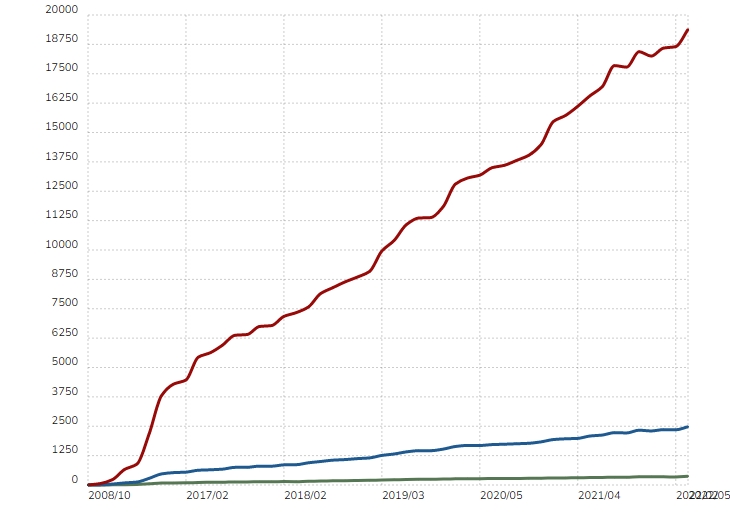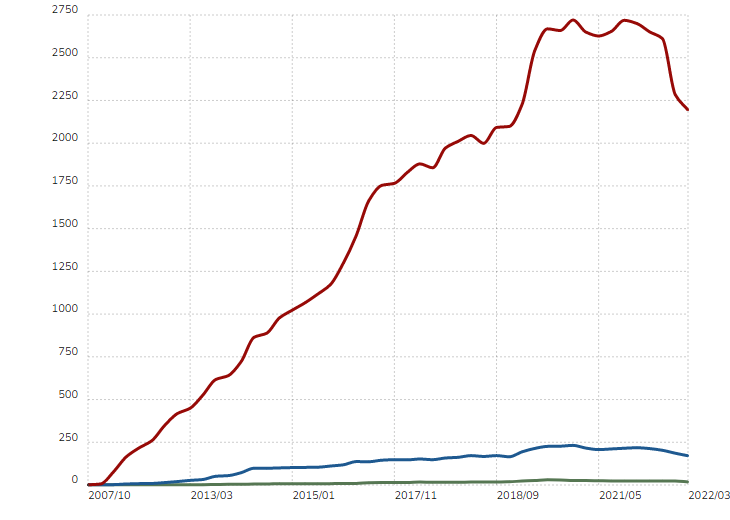
Shopify overview
In 2006, the Canadian ecommerce SaaS platform Shopify was launched.
In June 2009, it released an API to allow for the addition of applications and an app store to sell them.
The advantage of SaaS solutions is the speed with which you can create an online shop without real technical know-how. However, customization is limited and expensive.
In recent years, the number of Shopify stores has increased considerably, as it’s very easy to create one.
Here’s the growth curve for the number of Shopify stores:

Source: https://trends.builtwith.com/shop/Shopify
Introducing PrestaShop
- In 2007, students from Epitech (school for computer science and new technologies) created the open source CMS PrestaShop. At its inception, PrestaShop used an “in-house” framework that is currently being transitioned to Symfony.
- Today, it is the company of the same name that manages and maintains the PrestaShop open source project.
- The latest version is 1.7.8 (7.8 with the new version nomenclature); this is the version we will use in this comparison.
This is the PrestaShop online shop curve (all versions combined):

Source: https://trends.builtwith.com/shop/PrestaShop
Key points of comparison
The objective is to give you a practical guide to make the right choice between the 2 solutions and not a comparison of features. So we’re going to compare 5 points:
| Technical relevance | Explanation | |
| Community | +++ |
More advice and feedback on good practices |
| Price | + |
Easier launch and maintenance |
| Performance | +++ | Smoother navigation, better load support (visits) |
| SEO | ++ | Generates natural traffic to the website |
| Integrations | ++ |
Reduces costs, increases site quality by pooling developments. |
| Business relevance | Explanation | |
| Community | ++ |
Better support |
| Price | +++ |
Minimizes financial risks and boosts ROI |
| Performance | +++ | Decreases bounce rate and supports traffic peaks |
| SEO | +++ | Attracts new constumers without investing too much on paid ads |
| Integrations | ++ |
Easier to customize your online store thanks to the available modules by the solution |
- The community: this is an important factor, because it is the community that will be able to help you develop your site via partner agencies, help you configure your online store or find e-commerce solutions and implement them via the forums.
- The price: This is a determining factor in the choice of solution. We will compare the price of development, but also the price of maintenance, as well as the price of hosting, and thus present a global vision of all possible costs.
- Performance: this is a point that is sometimes underestimated. Performance (i.e. loading time and number of simultaneous connections) is one of the elements that guarantee the stability and scalability of an online store. A very greedy CMS will require higher hosting and/or SEA costs for a similar result compared to a lighter site.
- SEO: It has been known for a while that an e-commerce website needs the most efficient natural referencing in order to attract the most visitors possible.
- Integration: This is an often-overlooked factor. We will focus on the ability and ease of integrating new solutions or new features. If you still have to create your own module because there are none on the extensions site.
Comparison
Community
The Shopify community is difficult to estimate because the official forum is highly controlled by the company. However, you can find a lot of documentation and FAQs. Of course, there is no public Github account for this solution.
The PrestaShop community has more than 1,000,000 members overall (merchants, agencies, contributors, etc.), including 740 Github contributors. It is a very francophone and active community.
It’s difficult to make a comparison, because naturally, an open source CMS has a larger community than a SaaS solution. In an open source project, the community can directly contribute improvements and new features. While in a closed SaaS solution, it can only make suggestions.
Price
Creation of the online shop
Shopify is an e-commerce solution that allows you to create and add content very easily and quickly. However, customization is more complex and involves the use of applications that require knowledge of Python, JavaScript and PHP. In addition, many applications are paid monthly and can claim a portion of your turnover.
PrestaShop allows for high levels of customization since the code is open and accessible. It is possible to buy modules on the Addons marketplace of PrestaShop, as well as to create modules by mastering only PHP and JavaScript. Modules are usually purchased as a one-off payment, with prices ranging from €30 to €200 for the most part.
The ADR (Average Daily Rate) is roughly equal between the 2 solutions: €380. However, the development time can be slightly longer with Shopify, as it requires proficiency in 3 languages compared to 2 for PrestaShop.
Online store maintenance
For the addition or correction of new features, the prices will be equivalent because the ADR and development times are also equivalent. Nevertheless, the cost of the Shopify application (% of the turnover) should not be overlooked.
Hosting
This is a complex aspect to interpret given the various factors that come into play:
- Traffic on your e-commerce website
- The quantity of products in your online shop
- Specific developments
SaaS solutions generally offer very good performance because they control the code and infrastructure of the solution. So when you take out a subscription on Shopify, you are relying on a server configured and optimized for your solution.
On the other hand, you have to choose your hosting provider with PrestaShop, and this can be a difficult choice. But once you choose the host, you’ll pay a fixed amount, and everything on your server is yours. This makes data recovery much easier.
| Positives | Negatives | |
| Shopify |
Easy to get online Very simple to choose a hosting provider (a few packages) |
The data is not on your server, so you do not have full control of your data. |
| PrestaShop |
You have control over all your dataYou have control over all your data |
You must choose your hosting provider |
Performance
The differences in performance will depend mainly on the specific developments and the server you are going to use.
It is therefore very complicated, if not impossible, to have a clear-cut perspective on this issue. PrestaShop can be paired with cache systems like Varnish to boost its performance. Shopify offers good performance because the hosting is optimized for the Shopify solution, since the company manages this aspect itself 100%.
However, it must be taken into account that Shopify takes a part of the turnover and that this total amount (price of the package + % of the turnover) can equal a good server with PrestaShop with a suitable configuration, thereby guaranteeing equivalent performance to Shopify.
SEO
SEO represents the ability to attract visitors organically to an e-commerce website. Although both e-commerce solutions offer impressive natural referencing, the customization capabilities of PrestaShop will allow you to make optimizations that will be (depending on which) impossible or very complicated with Shopify: for example, changing the url format or changing the page markup is very complicated on Shopify, while it remains quite simple on PrestaShop.
Integration
The ability to integrate new tools into your e-commerce website is paramount, as it allows your site to evolve according to your needs and growth.
|
PrestaShop (v1.7.8) |
Shopify |
|
|
Module number |
||
|
Number of themes |
0 |
In terms of quantity, Shopify has more modules, which are largely made by the solution. This is a positive thing because it allows us to have developments consistent with the evolution and design of the CMS.
PrestaShop also offers a wide range of modules ranging from visual customization to the integration of payment methods or carriers.
The biggest difference is always in the price. We’ve talked about it a lot before, a Shopify application will usually cost more over time than a PrestaShop module.
The 2 e-commerce platform solutions offer complete APIs that allow for the integration of new tools.
These APIs cover a large part of your needs, for more specific cases:
- PrestaShop allows for the addition of new entry points to enrich the API
- Shopify is more complicated because developers only have the API, which makes adding new entry points complex.
Conclusion
Shopify advantages
- Shopify is an SaaS solution that allows you to quickly set up an online business.
- The customization is satisfactory and the solution offers good performance.
- There are a lot of apps to add third-party features or tools.
- This is an ideal solution when you’re starting an online business without any technical knowledge.
PrestaShop advantages
- PrestaShop is an open source solution that you will have to host, this may be a hindrance when setting up but once done you will have control over all your data.
- The diversity and quantity of the modules offer simple and affordable customization.
- PrestaShop will allow you to evolve and adapt your online business to your needs.
- It’s an ideal solution for any type of merchant who is looking for a simple and scalable solution.

Need expert advice for your migration project?
Learn more about how to migrate your ecommerce to PrestaShop with our specialists, no matter what your current CMS is.